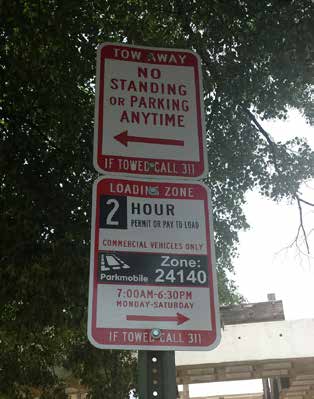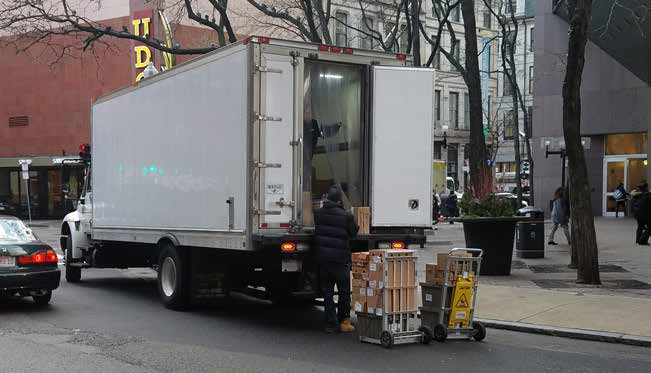Primer for Improved Urban Freight Mobility and Delivery
|
||
Key Accomplishments
|
In 2007, the DowntownDC Business Improvement District (BID) in Washington, DC, established a pilot parking program, which helped build momentum for developing the city's Commercial Loading Zone Management Program (CLZMP). Illegal double-parking of delivery vehicles can significantly increase congestion in urban areas. Increasing enforcement efforts can help ensure carriers are aware of loading zone areas and regulations. This strategy can be combined with increasing the availability of designated curbside access for commercial vehicles to both enforce existing regulations and address imbalances in supply and demand for loading zones.

Loading zone sign (bottom) in Washington, DC. Source: DDOT.
The pilot parking program first focused on K Street NW, one of the downtown's busiest commercial thoroughfares. Assisted by the District Department of Transportation and the Golden Triangle BID, the DowntownDC BID collected pre-and post-pilot data on travel times, parking occupancy, curbside uses, parking turnover, and parking violations. Results showed travel times across all modes of travel improved measurably following the pilot's implementation without a substantial disruption of commercial activity. This success eventually led to citywide implementation of the CLZMP in 2015.

A truck is unloaded at the curbside. Source: Volpe National Transportation Systems Center.
Communication and engagement were crucial to the successful implementation of the CLZMP. The District of Columbia DOT (DDOT) engaged in comprehensive stakeholder outreach to independent companies and distributors, carriers, national and State trucking associations, and local BIDs. It was critical for District DOT to convey the message that the CLZMP was intended to improve curbside management, not impose another tax on freight. DDOT also distributed literature about the CLZMP through print and online media. Additionally, DDOT coordinated with the City's Public Works and Police Departments to clarify regulations on design and placement of permit decals.
Improved enforcement of the CLZMP is the most important element of its success. To address carrier complaints about passenger vehicles using loading zone spaces, DDOT increased the fine for unauthorized vehicles from $50 to $100. Additionally, DDOT and the Public Works and Police Departments worked together to enforce the new regulations as the program rolled out. According to DDOT, jurisdictions interested in replicating this program should inventory existing loading zones and collect data on their use, coordinate with city police about enforcing loading zone changes, offer multiple methods of payment and investigate new forms of payment as they become available, and engage with carriers, downtown receivers, and local BIDs. Although DDOT did not collect data on loading zones prior to CLZMP, the initiative has resulted in better data on loading zone demand.
Laura Richards, Transportation Planner, DDOT, (202) 671-2226, laura.richards2@dc.gov
|
United States Department of Transportation - Federal Highway Administration |
||